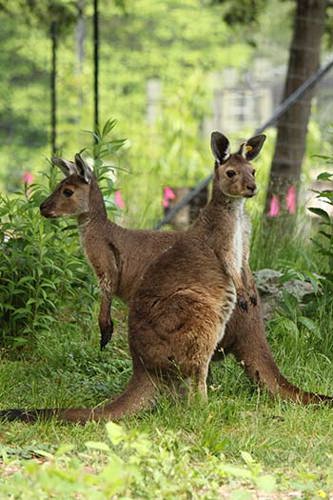Franklin Park Zoo welcomes western grey kangaroos
Tuesday June 20, 2023
 Visitors to Franklin Park Zoo will notice furry new faces on the Outback Trail with the recent addition of two western grey kangaroos: Auggie, male, and Opal, female, who are both one year old.
Visitors to Franklin Park Zoo will notice furry new faces on the Outback Trail with the recent addition of two western grey kangaroos: Auggie, male, and Opal, female, who are both one year old.
The grey kangaroos join the other residents on the Outback Trail including emus, red kangaroos, and red-necked wallabies, a species that made their exhibit debut in April.
“We’re so excited with the recent additions to our Outback Trail and delighted that guests will have the opportunity to observe the natural behaviors of these species as they explore their habitat,” said Ed O’Brien, an assistant curator at Zoo New England’s Franklin Park Zoo. “Both the red-necked wallaby and western grey kangaroo are cold-hardy species, so guests will have the opportunity to see them for much of the year.”
Franklin Park Zoo has been home to red kangaroos since 1998, but this is the first time that grey kangaroos will reside at the Zoo. Kangaroos are marsupials, like the red-necked wallabies they share a habitat with, and the red kangaroo the largest of all marsupials. Red kangaroos are sometimes grey in color, but guests can distinguish the two species by looking closely at their faces. Red kangaroos have distinctive markings along their muzzles and the sides of their face. Eastern grey kangaroos do not have these markings and their eyes are larger.
“It’s always a thrill when our Zoos welcome new animal residents,” said John Linehan, President and CEO of Zoo New England. “It’s especially exciting when it’s one we haven’t had before, such as grey kangaroos, which enables us to further connect guests to the incredible biodiversity found on our planet.”
Western grey kangaroos are native to Australia, a wealth of biodiversity and home to several regional species that are endangered. These habitats are an excellent example of how humans, wildlife and environments are interdependent. Australian wildlife face significant threats from human behaviors such as land modification, habitat destruction, and inappropriate fire management.
Western grey kangaroos live in small troops and congregate at preferred feeding and watering sites. These groups typically consist of females and their young, with males being solitary. Kangaroos have powerful hind legs, large feet, and a large muscular tail that helps with balance. It is the only large animal that hops as a primary means of mobility. They are good swimmers and have excellent hearing.

